Natural Science Papers by Ulrich Cubasch
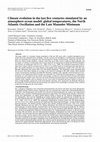
Meteorologische Zeitschrift, 2004
The main results of a transient climate simulation of the last 500 years with a coupled atmospher... more The main results of a transient climate simulation of the last 500 years with a coupled atmosphere-ocean model driven by estimated solar variability, volcanic activity and atmospheric concentrations of greenhouse gases are presented and compared with several empirical climate reconstructions. Along the last five centuries the climate model simulates a climate colder than mean 20th century conditions almost globally, and the degree of cooling is clearly larger than in most empirical reconstructions of global and North hemispheric near-surface air temperature . The simulated temperatures tend to agree more closely with the reconstruction of based on extratropical tree-ring chronologies. The model simulates two clear minima of the global mean temperature around 1700 A.D. (the Late Maunder Minimum) and around 1820 A.D. (the Dalton Minimum). The temperature trends simulated after the recovery from these minima are as large as the observed warming in the 20th century. More detailed results concerning the simulated Late Maunder Minimum, together with a spatially resolved historical reconstruction of the temperature field in Europe, are presented. It is found that the broad patterns of temperature deviations are well captured by the model, with stronger cooling in Central and Eastern Europe and weaker cooling along the Atlantic coast. However, the model simulates an intense drop of air-temperature in the North Atlantic ocean, together with an extensive sea-ice cover south of Greenland and lower salinity in North Atlantic at high latitudes, reminiscent of the Great Salinity Anomaly. Also, during the Late Maunder Minimum the intensities of the Golf Stream and the Kuroshio are reduced. This weakening is consistent with a reduced wind-stress forcing upon the ocean surface.
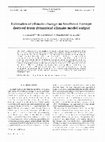
Climate Research 7, 129-149, 1996
Three methods of downscaling are applied to climate change experiments to obtain regional climat... more Three methods of downscaling are applied to climate change experiments to obtain regional climate information for Spain and the region designated as 'Southern Europe' by the lntergovernmental Panel on Climate Change (IPCC). The first method (direct interpolation of the grid points nearest the region analysed) gives a poor representation of the local climate. Its estimate of climate change simulated by different climate models is inconsistent. The success of the second method (timeslice), which uses a dynamical model to obtain the regional information, strongly depends on the horizontal resolution of the dynamical model. It provides the most reliable assessment of the regional climate, with the highest resolution. However, the computational expense of this high resolution limits the sample size. The third method (statistical downscaling) is an inexpensive tool for obtaining information on a regional scale. The problem is that this approach requires observational data sets to train the model. This limits the application of this method to well-observed quantities and regions. Both the time-slice and the statistical models indicate a lengthening of dry spells over Spain under CO2-doubling conditions.

GKSS Report 2003/12, 2003
In a transient climate simulation of the last 500 years with a coupled atmosphere-ocean model dri... more In a transient climate simulation of the last 500 years with a coupled atmosphere-ocean model driven by estimated solar variability, volcanic activity and atmospheric concentrations of greenhouse gases for the last centuries, the model simulates a climate colder than present conditions almost globally, and the degree of cooling is larger than most empirical reconstructions. The model simulates two clear minima of the global mean temperature around 1700 A.D. (the Late Maunder Minimum) and around 1820 A.D. (the Dalton Minimum). The temperature trends simulated after the recovery from these minima are as large as the observed warming in the 20th century. Additionally, in the Late Maunder Minimum the simulated temperature field in Europe agrees well with empirical reconstructions from proxy-data, with an intense drop of air-temperature in the North Atlantic ocean, an extensive sea-ice cover south of Greenland, lower salinity in North Atlantic at high latitudes, and reduced intensities of the Golf Stream and the Kuroshio Stream.
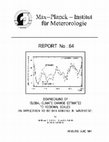
Journal of Climate 6: 1161-1171 , 1993
A statistical strategy to deduct regional~scale features from climate general circulation model (... more A statistical strategy to deduct regional~scale features from climate general circulation model (GCM) simulations has been designed and tested. The main idea is to interrelate the characteristic patterns of observed simultaneous variations of regional climate parameters and of large-scale atmospheric flow using the canonical correlation technique. The large-scale North Atlantic sea level pressure (SLP) is related to the regional, variable, winter (DJF) mean Iberian Peninsula rainfall. The skill of the resulting statistical model is shown by reproducing, to a good approximation, the winter mean Iberian rainfall from 1900 to present from the observed North Atlantic mean SLP distributions. It is shown that this observed relationship between these two variables is not well reproduced in the output of a general circulation model (GCM). The implications for Iberian rainfall changes as the response to increasing atmospheric greenhouse-gas concentrations simulated by two GCM experiments are examined with the proposed statistical model. In an instantaneous "2 CO~'' doubling experiment, using the simulated change of the mean North Atlantic SLP field to predict Iberian rainfall yields, there is an insignificant increase of area-averaged rainfall of l mm/month,
Rejected by nature; DOI 10.13140/2.1.3761.7445, 2002
With a state-of-the-art climate model, the effect of time varying solar and volcanic aerosol forc... more With a state-of-the-art climate model, the effect of time varying solar and volcanic aerosol forcing has been simulated. During the winters 1675-1710, a marked global cooling was simulated. This event mimics, in terms of broad patterns and time mean intensity, the strong cooling “Late Maunder Minimum” (LMM, 1675-1710) in Europe documented in various historical sources and early instrumental timeseries. The modelled LMM is causally related to the solar and volcanic forcing anomalies in the decades preceding and during the LMM creating an almost global cooling and large-scale circulation and sea ice coverage anomalies consistent with the phenomenon known as “Great Salinity Anomaly”.
Papers by Ulrich Cubasch
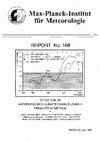
A fingerprint method for detecting anthropogenic climate change is applied to new simulations wit... more A fingerprint method for detecting anthropogenic climate change is applied to new simulations with a coupled ocean-atmosphere general circulation model (CGCM) forced by increasing concentrations of greenhouse gases and aerosols covering the years 1880 to 2050. In addition to the anthropogenic climate change signal, the space-time structure of the natural climate variability for near-surface temperatures is estimated from instrumental data over the last 134 years and two 1000 year simulations with CGCMs. The estimates are compared with paleoclimate data over 570 years. The space-time information on both the signal and the noise is used to maximize the signal-to-noise ratio of a detection variable obtained by applying an optimal filter (fingerprint) to the observed data. The inclusion of aerosols slows the predicted future warming. The probability that the observed increase in near-surface temperatures in recent decades is of natural origin is estimated to be less than 5 %. However, this number is dependent on the estimated natural variability level, which is still subject to some uncertainty.
EGU General Assembly Conference Abstracts, May 1, 2014
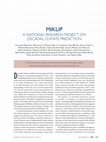
Bulletin of the American Meteorological Society, 2016
Mittelfristige Klimaprognose (MiKlip), an 8-yr German national research project on decadal climat... more Mittelfristige Klimaprognose (MiKlip), an 8-yr German national research project on decadal climate prediction, is organized around a global prediction system comprising the Max Planck Institute Earth System Model (MPI-ESM) together with an initialization procedure and a model evaluation system. This paper summarizes the lessons learned from MiKlip so far; some are purely scientific, others concern strategies and structures of research that target future operational use. Three prediction system generations have been constructed, characterized by alternative initialization strategies; the later generations show a marked improvement in hindcast skill for surface temperature. Hindcast skill is also identified for multiyear-mean European summer surface temperatures, extratropical cyclone tracks, the quasi-biennial oscillation, and ocean carbon uptake, among others. Regionalization maintains or slightly enhances the skill in European surface temperature inherited from the global model and...
Climate of the Past Discussions, 2013
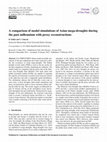
Climate of the Past, 2015
Two PMIP3/CMIP5 climate model ensemble simulations of the past millennium have been analysed to i... more Two PMIP3/CMIP5 climate model ensemble simulations of the past millennium have been analysed to identify the occurrence of Asian mega-droughts. The Palmer drought severity index (PDSI) is used as the key metric for the data comparison of hydro-climatological conditions. The model results are compared with the proxy data of the Monsoon Asia Drought Atlas (MADA). Our study shows that global circulation models (GCMs) are capable of capturing the majority of historically recorded Asian monsoon failures at the right time and with a comparable spatial distribution. The simulations indicate that El Niño-like events lead, in most cases, to these droughts. Both model simulations and proxy reconstructions point to fewer monsoon failures during the Little Ice Age. The results suggest an influential impact of volcanic forcing on the atmosphere-ocean interactions throughout the past millennium. During historic megadroughts of the past millennium, the monsoon convection tends to assume a preferred regime described as a "break" event in Asian monsoon. This particular regime is coincident with a notable weakening in the Pacific trade winds and Somali Jet.
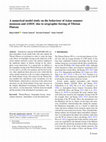
Climate Dynamics, 2015
Simulations using the ECHAM5/MPI-OM coupled atmosphere-ocean model both with and without the Tibe... more Simulations using the ECHAM5/MPI-OM coupled atmosphere-ocean model both with and without the Tibetan Plateau are performed in order to study the large scale effects of orographic forcing on the behaviour of the Asian summer monsoon system. Our analysis emphasises the significant impact of plateau forcing on the atmosphere-ocean interactions. It is argued that, in addition to the orographic forcing of the Tibetan Plateau on the climate of Asia such as sensible heat pumping and thermal insulation, other significant direct processes exist, which link the Asian summer monsoon to the sea surface temperatures in the North Atlantic Ocean. The removal of the Tibetan Plateau modifies the wind-driven ocean circulations over the North Atlantic, which leads to a decrease in the surface heat advection over the North Atlantic Ocean and a decrease in the Atlantic Meridional Overturning Circulation. This, in turn, affects, via teleconnections, both the monsoon rainfall and the position of the intertropical convergence zone.
Quaternary International, 2017
The evidence of climate change from observations of the atmosphere and surface has grown signific... more The evidence of climate change from observations of the atmosphere and surface has grown significantly during recent years. At the same time new improved ways of characterizing and quantifying uncertainty have highlighted the challenges that remain for developing long-term global and regional climate quality data records. Currently, the obser¬vations of the atmosphere and surface indicate the following changes
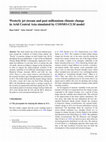
Theoretical and Applied Climatology, 2015
This study tackles one of the most debated questions around the evolution of Central Asian climat... more This study tackles one of the most debated questions around the evolution of Central Asian climate: the "Puzzle" of moisture changes in Arid Central Asia (ACA) throughout the past millennium. A state-of-the-art Regional Climate Model (RCM) is subsequently employed to investigate four different 31-year time slices of extreme dry and wet spells, chosen according to changes in the driving data, in order to analyse the spatio-temporal evolution of the moisture variability in two different climatological epochs: Medieval Climate Anomaly (MCA) and Little Ice Age (LIA). There is a clear regime behavior and bimodality in the westerly Jet phase space throughout the past millennium in ACA. The results indicate that the regime changes during LIA show a moist ACA and a dry East China. During the MCA, the Kazakhstan region shows a stronger response to the westerly jet equatorward shift than during the LIA. The out-of-phase pattern of moisture changes between India and ACA exists during both the LIA and the MCA. However, the pattern is more pronounced during the LIA.
Global and Planetary Change, 2014
Engineering Applications of Artificial Intelligence, 2015

Climate of the Past Discussions, 2006
Climate simulations of the Eemian interglacial and the last glacial inception have been performed... more Climate simulations of the Eemian interglacial and the last glacial inception have been performed by forcing a coupled ocean-atmosphere general circulation model with insolation patterns of these periods. The parameters of the Earth's orbit have been set to conditions of 125 000 and 115 000 years before present (yr BP). Compared to today, these dates represent periods with enhanced and weakened seasonality of insolation on the northern hemisphere. Here we analyze the simulated change in winter storm tracks. The change in the orbital configuration has a strong impact on the meridional temperature gradients and therefore on strength and location of the storm tracks. The North Atlantic storm track is strenghtened, shifted northward and extends further to the east in the simulation for the Eemian at 125 kyr BP. As one consequence, the northern parts of Europe experience an increase in winter precipitation. The frequency of winter storm days increases over large parts of the North Atlantic. Opposite but weaker changes in storm track activity are simulated for 115 kyr BP.
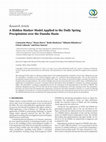
Advances in Meteorology, 2014
The main goal of this study is to obtain an improvement of the spring precipitation estimation at... more The main goal of this study is to obtain an improvement of the spring precipitation estimation at local scale, taking into account the atmospheric circulation on the Atlantic-European region, by a statistical downscaling procedure. First we have fitted the precipitation amounts from the 19 stations with a HMM with 7 states. The stations are situated in localities crossed by the Danube or situated on the principal tributaries. The number of hidden states has been determined by means of BIC values. A NHMM has been applied then to precipitation occurrence associated with the information about atmospheric circulation over Atlantic-European region. The atmospheric circulation is quantified by the first 10 components of the decomposition in the EOFs or MEOFs. The predictors taking into account CWTs for SLP and the first summary variable from a SVD have also been tested. The atmospheric predictors are derived from SLP, geopotential, temperature, and specific and relative humidity at 850 hP...











Uploads
Natural Science Papers by Ulrich Cubasch
Papers by Ulrich Cubasch
This strategy is applied to detecting a greenhouse-gas-induced climate change in the spatial pattem of near-surface temperature trends defined for time intervals of 15-30 years. The expected pattem of climate change is derived from a transient simulation with a coupled ocean-atmosphere general circulation model. Global gridded near-surface temperature observations are used to represent the observed climate change. Information on the natural variability needed to establish the statistics of the detection variable is extracted from long control simulations of coupled ocean-atmosphere models and, additionally, from the observations themselves (from which an estimated greenhouse warming signal has been removed). While the model control simulations contain only variability caused by the internal dynamics of the atmosphere-ocean system, the observations additionally contain the response to various extemal forcings (e.g., volcanic eruptions, changes in solar radiation, and residual anthropogenic forcing). The resulting estimate of climate noise has large uncertainties but is qualitatively the best the authors can presently offer.
The null hypothesis that the latest observed 2O-yr and 3O-yr trend of near-surface temperature (ending in 1994) is part of natural variability is rejected with a risk of less than 2.5% to 5% (the 5% level is derived from the variability of one model control simulation dominated by a questionable extreme event). In other words, the probability that the warming is due to our estimated natural variability is less than 2.5% to 5%. The increase in the signal-to-noise ratio by optimization of the fingerprint is of the order of 10%-30% in most cases.
The predicted signals are dominated by the global mean component; the pattem correlation excluding the global mean is positive but not very high. Both the evolution of the detection variable and also the pattem correlation results are consistent with the model prediction for greenhouse-gas-induced climate change. However, in order to attribute the observed warming uniquely to anthropogenic greenhouse gas forcing, more information on the climate's response to other forcing mechanisms (e.g., changes in solar radiation, volcanic, or anthropogenic sulfate aerosols) and their interaction is needed.
It is concluded that a statistically significant externally induced warming has been observed, but our caveat that the estimate of the internal climate variability is still uncertain is emphasized"